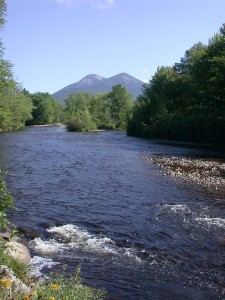Written in the Rocks and Sand
 The Connecticut River is like the trunk of a great tree whose branches are its many tributary rivers and streams. Everything that lies between Vermont’s Green Mountains and New Hampshire’s White Mountains is part of a landscape shaped by moving water, and it’s all gathered into the great flow of this single river. It begins 2,670 feet above sea level a few steps from Canada and runs down the length of New England.
The Connecticut River is like the trunk of a great tree whose branches are its many tributary rivers and streams. Everything that lies between Vermont’s Green Mountains and New Hampshire’s White Mountains is part of a landscape shaped by moving water, and it’s all gathered into the great flow of this single river. It begins 2,670 feet above sea level a few steps from Canada and runs down the length of New England.
Your experience of the Connecticut River Valley has been millions of years in preparation. Eons ago, our rolling hills were towering mountain ranges. Mile-thick glaciers once covered the land and as they melted, icy waters inundated the Valley in a lake of great depth.
Today we enjoy a temperate climate and the ever-changing variety of four seasons. But you can still read the signs of nature’s hand upon our mountains, streams, and forests. Our 19th century downtowns and historic neighborhoods were set out on sandy, level terraces deposited in that glacial lake more than 10,000 years ago. Small villages and even our largest urban centers are integrated with the natural landscape. Migratory waterfowl still return along river routes as they have for millennia, reminding us of our place in the scheme of things. Somewhere among our scenic vistas and intimate environments is a habitat for you.
As you travel through the Byway region, you are in the northern portion of a wildlife refuge that takes in the entire Connecticut River watershed. The Silvio O. Conte National Fish and Wildlife Refuge covers 7.2 million acres in four states. The Conte Refuge is based on partnerships between the federal agency and states, communities, and private organizations to protect fish and wildlife habitats and natural diversity. Its education centers offer a fascinating glimpse into the life of the river.
The Fairbanks Museum and Planetarium in St. Johnsbury, VT, is northern New England’s premiere museum of natural history. Established in 1889, it still follows its founder’s vision to “stimulate understanding of the natural and human environments and their interrelationships, through programs, exhibits, services, and collections.” With more than 18,000 square feet of exhibits – and a planetarium – the Fairbanks displays more than 150,000 objects from nature and cultures around the world. Look for comprehensive collections of northern New England’s birds and wildlife, a spectacular array of large mounted mammals, and a remarkable photographic collection of snowflakes made in the 19th century by “Snowflake” Bentley, Vermont’s singular student of snow.
The Montshire Museum in Norwich, VT, is a hands-on science museum with dozens of exhibits relating to the natural and physical sciences, technology, and ecology, including the Conte Refuge. The self-guiding museum, featuring exhibits both indoors and out, is engaging for adults and children of all ages, and is located on a 110-acre site on the Connecticut River with a network of easy-to-moderate walking trails.
The Vermont Institute of Natural Science in Quechee, VT offers year-round educational programs, camps, workshops, events and tours designed to engage people and their communities in the active care of their environment. Its live raptor rehabilitation exhibits are a particular favorite of many return visitors. VINS and the U.S. Fish and Wildlife Service offer programs and exhibits highlighting the array of wildlife and habitats found on the Silvio O. Conte National Fish and Wildlife Refuge and their conservation efforts.
The Waypoint Communities, Interactive Map and our Travel the Byway Itineraries will guide you to even more information about what to see and do here in the valley of the Connecticut River.